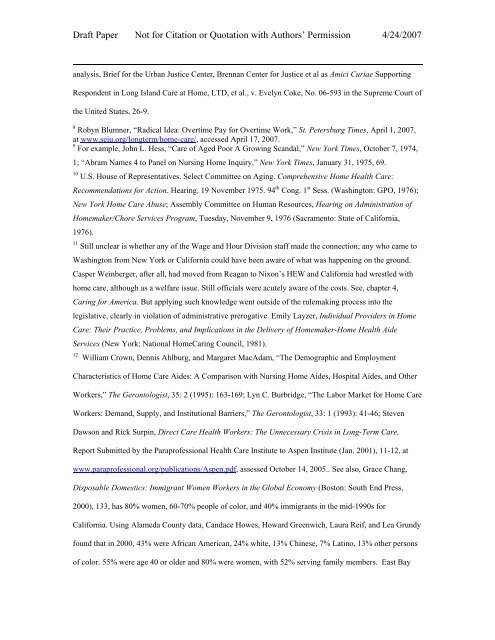Organizing Home Care: - School of Social Service Administration
Organizing Home Care: - School of Social Service Administration
Organizing Home Care: - School of Social Service Administration
Create successful ePaper yourself
Turn your PDF publications into a flip-book with our unique Google optimized e-Paper software.
Draft Paper Not for Citation or Quotation with Authors’ Permission 4/24/2007<br />
analysis, Brief for the Urban Justice Center, Brennan Center for Justice et al as Amici Curiae Supporting<br />
Respondent in Long Island <strong>Care</strong> at <strong>Home</strong>, LTD, et al., v. Evelyn Coke, No. 06-593 in the Supreme Court <strong>of</strong><br />
the United States, 26-9.<br />
8 Robyn Blumner, “Radical Idea: Overtime Pay for Overtime Work,” St. Petersburg Times, April 1, 2007,<br />
at www.seiu.org/longterm/home-care/, accessed April 17, 2007.<br />
9 For example, John L. Hess, “<strong>Care</strong> <strong>of</strong> Aged Poor A Growing Scandal,” New York Times, October 7, 1974,<br />
1; “Abram Names 4 to Panel on Nursing <strong>Home</strong> Inquiry,” New York Times, January 31, 1975, 69.<br />
10 U.S. House <strong>of</strong> Representatives. Select Committee on Aging. Comprehensive <strong>Home</strong> Health <strong>Care</strong>:<br />
Recommendations for Action. Hearing. 19 November 1975. 94 th Cong. 1 st Sess. (Washington: GPO, 1976);<br />
New York <strong>Home</strong> <strong>Care</strong> Abuse; Assembly Committee on Human Resources, Hearing on <strong>Administration</strong> <strong>of</strong><br />
<strong>Home</strong>maker/Chore <strong>Service</strong>s Program, Tuesday, November 9, 1976 (Sacramento: State <strong>of</strong> California,<br />
1976).<br />
11 Still unclear is whether any <strong>of</strong> the Wage and Hour Division staff made the connection; any who came to<br />
Washington from New York or California could have been aware <strong>of</strong> what was happening on the ground.<br />
Casper Weinberger, after all, had moved from Reagan to Nixon’s HEW and California had wrestled with<br />
home care, although as a welfare issue. Still <strong>of</strong>ficials were acutely aware <strong>of</strong> the costs. See, chapter 4,<br />
Caring for America. But applying such knowledge went outside <strong>of</strong> the rulemaking process into the<br />
legislative, clearly in violation <strong>of</strong> administrative prerogative. Emily Layzer, Individual Providers in <strong>Home</strong><br />
<strong>Care</strong>: Their Practice, Problems, and Implications in the Delivery <strong>of</strong> <strong>Home</strong>maker-<strong>Home</strong> Health Aide<br />
<strong>Service</strong>s (New York: National <strong>Home</strong>Caring Council, 1981).<br />
12 William Crown, Dennis Ahlburg, and Margaret MacAdam, “The Demographic and Employment<br />
Characteristics <strong>of</strong> <strong>Home</strong> <strong>Care</strong> Aides: A Comparison with Nursing <strong>Home</strong> Aides, Hospital Aides, and Other<br />
Workers,” The Gerontologist, 35: 2 (1995): 163-169; Lyn C. Burbridge, “The Labor Market for <strong>Home</strong> <strong>Care</strong><br />
Workers: Demand, Supply, and Institutional Barriers,” The Gerontologist, 33: 1 (1993): 41-46; Steven<br />
Dawson and Rick Surpin, Direct <strong>Care</strong> Health Workers: The Unnecessary Crisis in Long-Term <strong>Care</strong>,<br />
Report Submitted by the Parapr<strong>of</strong>essional Health <strong>Care</strong> Institute to Aspen Institute (Jan. 2001), 11-12, at<br />
www.parapr<strong>of</strong>essional.org/publications/Aspen.pdf, assessed October 14, 2005.. See also, Grace Chang,<br />
Disposable Domestics: Immigrant Women Workers in the Global Economy (Boston: South End Press,<br />
2000), 133, has 80% women, 60-70% people <strong>of</strong> color, and 40% immigrants in the mid-1990s for<br />
California. Using Alameda County data, Candace Howes, Howard Greenwich, Laura Reif, and Lea Grundy<br />
found that in 2000, 43% were African American, 24% white, 13% Chinese, 7% Latino, 13% other persons<br />
<strong>of</strong> color. 55% were age 40 or older and 80% were women, with 52% serving family members. East Bay
















